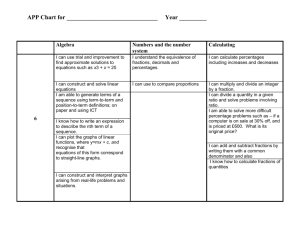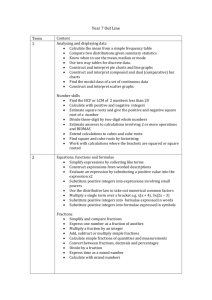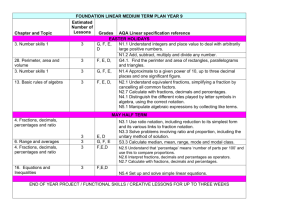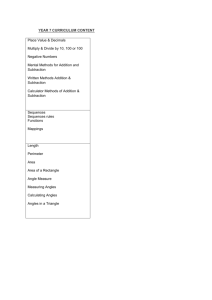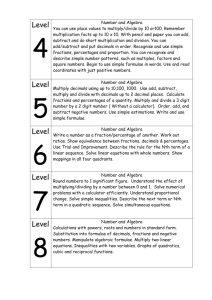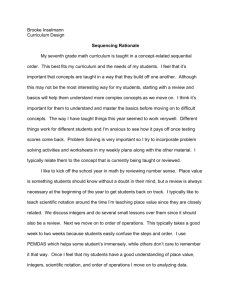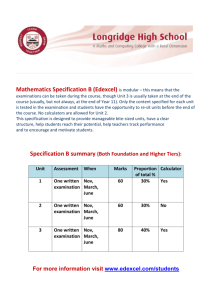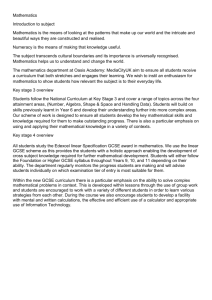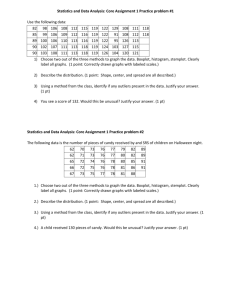Key Stage 3 Key objectives – as at June 2000
advertisement
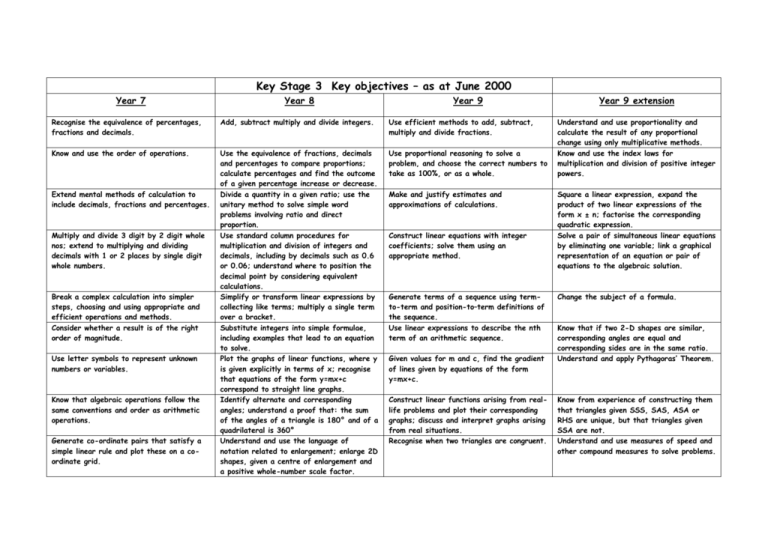
Key Stage 3 Key objectives – as at June 2000 Year 7 Year 8 Year 9 Recognise the equivalence of percentages, fractions and decimals. Add, subtract multiply and divide integers. Use efficient methods to add, subtract, multiply and divide fractions. Know and use the order of operations. Use the equivalence of fractions, decimals and percentages to compare proportions; calculate percentages and find the outcome of a given percentage increase or decrease. Divide a quantity in a given ratio; use the unitary method to solve simple word problems involving ratio and direct proportion. Use standard column procedures for multiplication and division of integers and decimals, including by decimals such as 0.6 or 0.06; understand where to position the decimal point by considering equivalent calculations. Simplify or transform linear expressions by collecting like terms; multiply a single term over a bracket. Substitute integers into simple formulae, including examples that lead to an equation to solve. Plot the graphs of linear functions, where y is given explicitly in terms of x; recognise that equations of the form y=mx+c correspond to straight line graphs. Identify alternate and corresponding angles; understand a proof that: the sum of the angles of a triangle is 180° and of a quadrilateral is 360° Understand and use the language of notation related to enlargement; enlarge 2D shapes, given a centre of enlargement and a positive whole-number scale factor. Use proportional reasoning to solve a problem, and choose the correct numbers to take as 100%, or as a whole. Extend mental methods of calculation to include decimals, fractions and percentages. Multiply and divide 3 digit by 2 digit whole nos; extend to multiplying and dividing decimals with 1 or 2 places by single digit whole numbers. Break a complex calculation into simpler steps, choosing and using appropriate and efficient operations and methods. Consider whether a result is of the right order of magnitude. Use letter symbols to represent unknown numbers or variables. Know that algebraic operations follow the same conventions and order as arithmetic operations. Generate co-ordinate pairs that satisfy a simple linear rule and plot these on a coordinate grid. Make and justify estimates and approximations of calculations. Construct linear equations with integer coefficients; solve them using an appropriate method. Generate terms of a sequence using termto-term and position-to–term definitions of the sequence. Use linear expressions to describe the nth term of an arithmetic sequence. Given values for m and c, find the gradient of lines given by equations of the form y=mx+c. Construct linear functions arising from reallife problems and plot their corresponding graphs; discuss and interpret graphs arising from real situations. Recognise when two triangles are congruent. Year 9 extension Understand and use proportionality and calculate the result of any proportional change using only multiplicative methods. Know and use the index laws for multiplication and division of positive integer powers. Square a linear expression, expand the product of two linear expressions of the form x ± n; factorise the corresponding quadratic expression. Solve a pair of simultaneous linear equations by eliminating one variable; link a graphical representation of an equation or pair of equations to the algebraic solution. Change the subject of a formula. Know that if two 2-D shapes are similar, corresponding angles are equal and corresponding sides are in the same ratio. Understand and apply Pythagoras’ Theorem. Know from experience of constructing them that triangles given SSS, SAS, ASA or RHS are unique, but that triangles given SSA are not. Understand and use measures of speed and other compound measures to solve problems. Assessment Tracker Key Stage 3 Key objectives (2) Year 7 Year 8 Year 9 Identify parallel and perpendicular lines; know the sum of angles at a point, on a straight line and in triangles. Use straight edge and compasses to do standard constructions. Solve problems using side, angle and symmetry properties of polygons, and angle properties of parallel and intersecting lines. Convert one metric unit to another. Deduce and use formulae for the area of a triangle and parallelogram, and the volume of a cuboid; calculate volumes and surface areas of cuboids and compound shapes made from cuboids. Decide which data to collect to answer a question, and the degree of accuracy needed, and identify possible sources. Draw and produce, on paper and using ICT, a range of graphs and charts; identify which are most useful in the context of a problem. Know that translations, rotations and reflections preserve length and angle and map objects onto congruent images. Read and interpret scales on a range of measuring instruments. Compare 2 distributions using the range and one of the measures of average. Understand and use the probability scale from 0 to 1; find and justify probabilities based on equally likely outcomes in simple contexts. Solve mathematical problems and puzzles in a range of contexts. Explain and justify methods and conclusions. Understand the significance of a counterexample when looking for generality. Find and record all possible outcomes for single events and two successive events in a systematic way, using diagrammatic and tabular forms of presentation. Identify the necessary information to solve a problem; represent problems and solutions in algebraic, geometric or graphical form. Explain and justify references and reasoning. Know and use the formulae for the circumference and area of a circle. Design a survey or experiment to capture the necessary data from one or more sources; determine the sample size and degree of accuracy needed; design, trial and if necessary refine data-collection sheets. Communicate interpretations and results of a statistical enquiry using selected tables, graphs and diagrams in support. Know that the sum of probabilities of all mutually exclusive outcomes is 1 and use this when solving problems. Solve substantial problems by breaking them into simpler tasks, using a range of efficient techniques, methods and resources, including ICT. Present a precise, reasoned argument, making use of symbols, diagrams and graphs and related explanatory text; give solutions to an appropriate degree of accuracy. Year 9 extension Identify possible sources of bias in a statistical enquiry and justify choice of statistical representation in written presentations. Generate fuller solutions to mathematical problems. Recognise limitations on the accuracy of data and measurements.
